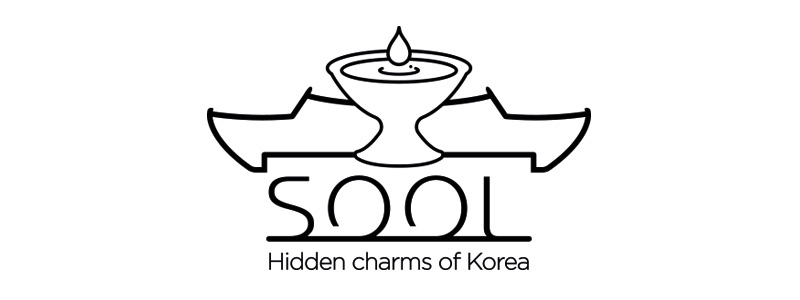
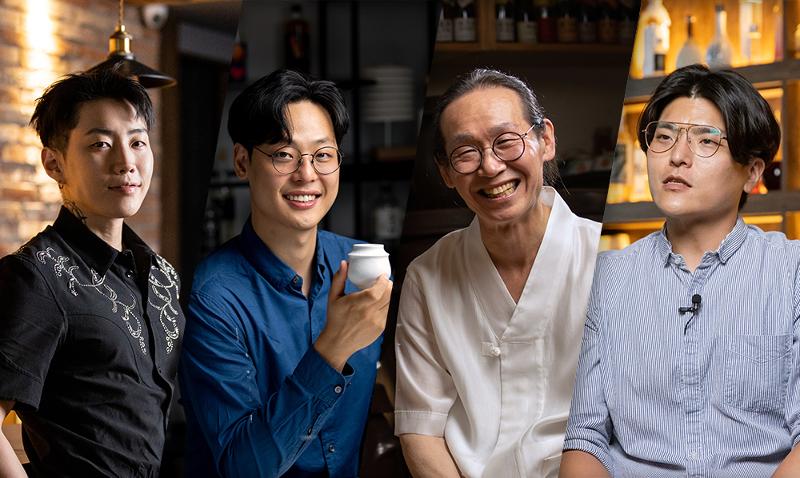
From left are Won Spirits CEO Jay Park, Damhwa CEO Lee Jaeook, Korea Studio Sool Director Park Rokdam and Won Spirits Chief Communications Officer Kim Hee-jun.
By Min Yea-Ji
Photos = Kim Sunjoo
Video = Lee Jun Young
Rapper Psy's music video "Hangover" from 2014 offers a glimpse of Korean drinking culture.
After giving a toast, he slightly tilts his head to the side, takes a sip from his glass, makes a poktanju (boilermaker) of soju (clear distilled alcoholic beverage) and beer and hits a sauna the next day to relieve his hangover. About eight years after this song's release, Korea has seen many changes in its market and culture of consuming alcohol.
Even foreign drinkers with a harsh opinion of Korean booze give a thumbs up to the country's diversified culture of enjoying drinks while socializing. Korea.net interviewed four experts in sool (alcoholic drinks) to learn more about domestic drinking culture: Jay Park, head of Won Spirits, a company that popularized nonmainstream distilled soju, and assisted by his company's chief communications officer Kim Hee-jun; Lee Jaeook, CEO of the nation's first traditional sool subscription platform Damhwa; and Park Rokdam, director of Korea Studio Sool who has restored over 800 types of traditional sool.
Won Spirits' hit brand Wonsoju is one of this year's leading keywords on the domestic booze market. Why did you pick soju and its distilled versions?
Park: As I got older, I preferred going to drinking places where I could chat in peace instead of those with loud music. I thought soju fits such a place. I decided to directly make soju myself and as I studied it, my desire to make good soju grew. Few people think that soju in green bottles is fancy or of high-quality, and I wanted to change that perception. I developed a sense of pride in distilled soju, which is truly a "precious drink." I'm extremely picky about organic and healthy food or drinks. If drinking, isn't it better to drink something healthy?
Park and Kim: What's important is that we still enjoy and love the diluted soju in green bottles. We also want to say these are not all there is to Korean booze.
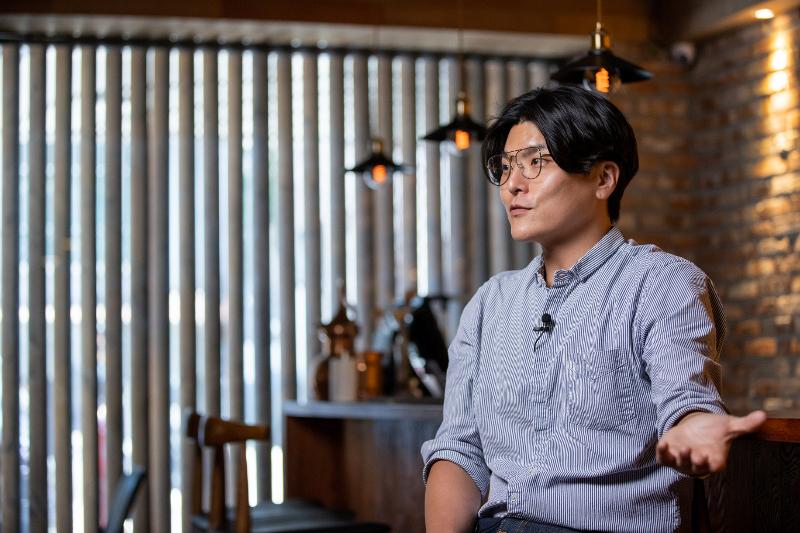
Won Spirits Chief Communications Officer Kim Hee-jun
Soju in a green bottle is essential for making boilermakers served at a hoesik (after-work or social gathering). How is drinking at a hoesik?
Kim: When starting my career, I often went drinking to appease my bosses and drank booze I didn't like and boilermakers that didn't suit me. Honestly, I dislike this drinking culture.
Park: But when you attend a hoesik and drink together, you develop friendship and grow closer. I realized that's why we have a hoesik.
Kim: I agree. Just like pairings of alcoholic beverages and food, pairings of people occur when drinking together. This pairing process is what I like most at a hoesik.
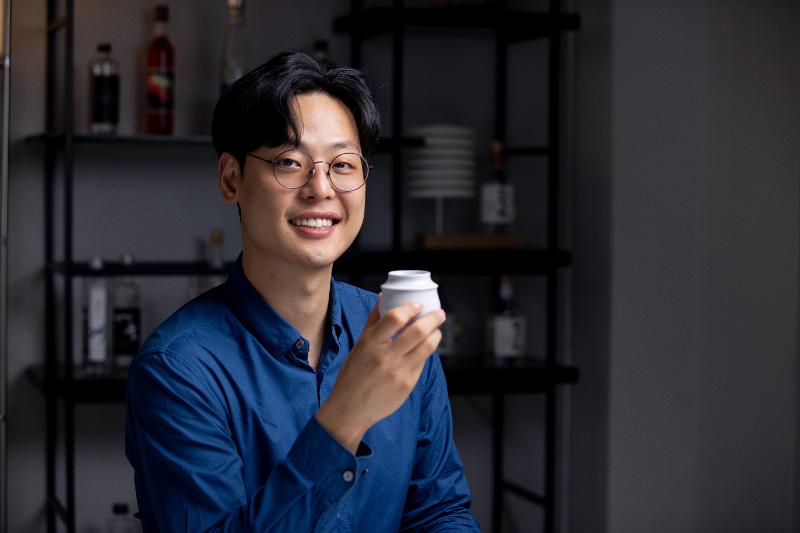
Damhwa CEO Lee Jaeook
You opened the country's first traditional sool subscription platform amazingly as a young 20-something man. How did you grow interested in this?
Lee: I didn't know much about traditional booze because I went to university in Hong Kong. I went to a traditional booze expo by chance and learning about the diversity of our traditional sool hit me like a hammer. Traditional booze was the only type of alcoholic beverage in Korea purchasable online. But the process was complicated and I didn't know what type to buy. So I decided to start blazing a trail.
How do you decide what booze to recommend to buyers?
Lee: In the past, we provided very basic explanations like traditional booze is good with a long history. Just as people want to take the "selfie of a lifetime," we help them find the "sool of a lifetime" for a special occasion. We explain what drink goes with what occasion, what foods go well with it and how it tastes.
What do subscribers to your traditional booze service want?
Lee: Users of our Sooldamhwa service make expensive purchases through subscription. You can easily find soju and beer at convenience stores but users of our service can try new drinks every month. I think our subscribers value food and booze far more than others. I think our customers want to enjoy good booze even if just one glass and want value consumption.
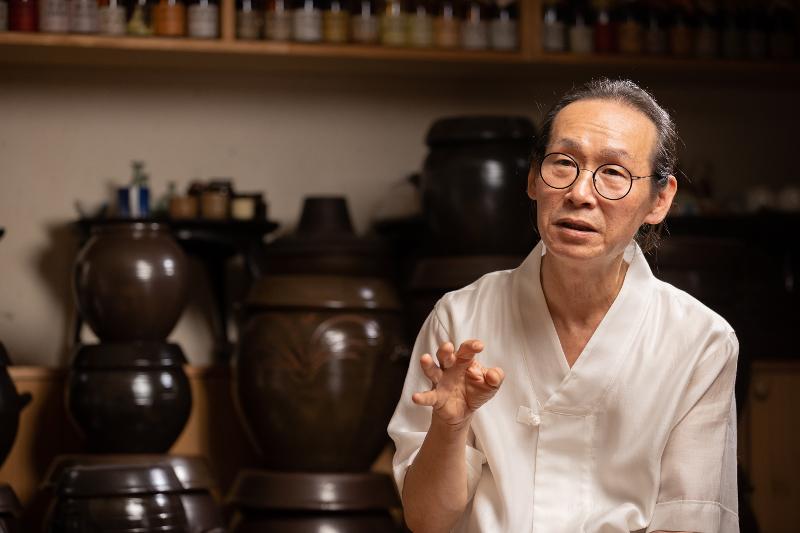
Korea Studio Sool Director Park Rokdam
Poktanju consisting a glass of beer with a shot of soju is an integral part of Korean drinking culture. When did this domestic version of a boilermaker begin?
Park: A boilermaker is a recent trend and not from the culture our ancestors enjoyed. Such culture began due to industrialization, emergence of inexpensive booze and shift of drinking venue from indoors to outdoors. The boilermaker practice began as people started mixing strong soju with fermented alcohol so that they could quickly get drunk outdoors. The low cost led to excessive and binge drinking.
How did Koreans originally enjoy sool?
Park: The culture was drinking booze with a meal. People didn't need to drink much since they were full from their meals. Above all, drinking involved style and taste. Classical scholars recited poems as they drank, and drinking also accompanied music or dance and led to the creation of artistic genres such as painting and calligraphy. There is nothing to learn from a drinking culture of chanting "Pour and drink more!"
The social atmosphere now and at the time of the Joseon Dynasty (1392-1910) are vastly different. Doesn't that make comparisons between the two eras difficult?
Park: I'm not saying go back to the Joseon Dynasty but to proactively rebuild our drinking culture. The hope is in young people beginning to study our drinking culture and learning how to make and drink sool. When I launched the studio 25 years ago, the average age of a student was 58. We had one or two in their 30s and 40s, as rare as finding beans sprouting during a drought. Today, the average student is in his or her 30s. Change has begun. I believe that they will become leaders in society a decade or two from now and consequently change our drinking culture.
What is something the world should know about Korean drinking culture?
Park: It's sad when foreign nationals hear of makgeolli (milky rice wine) and mainly think of the drink poured through a yellow kettle. We drank like that for just 20 years after the Korean War (1950-53), when the country saw the worst poverty in its history. I just want to say our sool has been consumed in Korea in Goryeo celadon, Joseon porcelain, ceramics and bronzeware.
jesimin@korea.kr